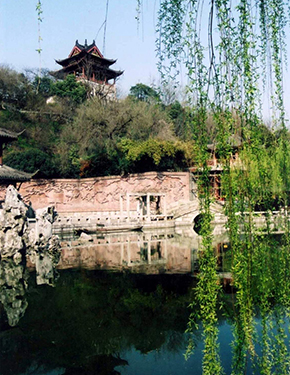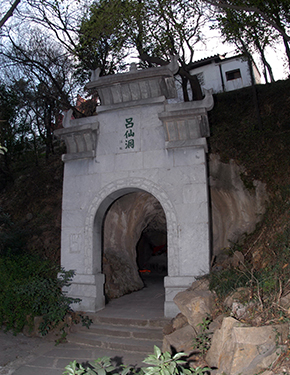
Moon-Surging Terrace
- Nomal
- Enlarge
- Reduce

The terrace finds its location in the Southern Section of the park, 266 m east of Yellow Crane Tower and 10 m or so southwest of White Cloud Pavilion. It is actually a Ming-Qing building in close touch with the main tower.
There is no record or material to locate its first construction era. However, extant poems and essays give us a clue to the dating of this terrace. That is about the 16th century in Ming Era. Allegedly, the rock inscription “Yong Yue” on Phoenix-Perching Mountain (now Phoenix Mountain) behind the Town God Temple of Hanyang Prefecture appeared earlier than the pavilion of the same name. Gazetteer of Hanyang Prefecture compiled by Zhu Yi in the 25th Year (1546) of Ming’s Jiajing Period writes alike, “Moon-Surging Pavilion towers atop Phoenix-Perching Mountain north of the county seat. Now the rock still features two characters meaning ‘Surging Moon.’ ” In late Ming, Tan Youxia and Liu Furen bumped into the inscription among the desolate grass on the back of the mountain. Then they asked Xu Ziqing to move it south to the left side of the Hall of Taibai beside Yellow Crane Tower. In Qing’s Kangxi Period, stones were laid to form a pedestal on which the inscription was later placed. A contemporary added “Tai” (pedestal) to the end of the inscription. But when it came to Qianlong Period, the stele had been truncated, with only “Yong Yue” intact. Then the remainder was moved to the bottom of Doulao Pavilion. In the 20th Year (1815) of Jiaqing Period, Xiong Shipeng picked up the splinter and evened out the Xi Shuang inscription and imitated Yong Yue at the same time. Later the columns got heightened to erect a terrace. Due to weathering, the character Yong (Surge) became broken, the character Yue (Moon) became a bit mutilated and the upper part of Tai (terrace) had missed. In 1955, the terrace was dismantled as the Yangtze Bridge would occupy that site. Those stone columns of Qing Dynasty were relocated to Wuchang Uprising Park on the south end of Snake Mountain. In addition, the pillars have three pairs of couplets,
The bright moon holds no stain;The great river has its mighty voice.
Look afar: In the Milky Way, a silvery moon looks unlike the Dew-Holding Plate;
Listen now: In the Azure Sky, the whooping crane sounds unlike the Wind Rising Song.
The past venue witnessed hilarious drinking under the moon;
The present edifice invites all for touring around the ambience.
The front rock frame features an inscription “Yong Yue Tai (Moon-Surging Terrace)” featuring vigorous brushwork and lofty antiquity. “Yong Yue,” “Ya Yun” and “Qin Tai (Zither Terrace)” are recorded to have been Three Masterworks of Ancient Calligraphy for Wuhan. Investigation shows the first inscription was created by Huang Qinglao.
Huang Qinglao, styled Zisu and self-named Qiaoshui, found his ancestral home in Gushi, Henan and later moved to Shaowu, Fujian. In the 4th Year (1327) of Yuan’s Taiding Period, he served as Compiler of Hanlin Academy, being venerated for his learning and virtues. Huang began holding Confucian Supervisor of Huguang Branch Secretariat in the 1st Year (1341) of Emperor Huizong’s Zhizheng Period, and died in Jiangxia (Wuchang District, Wuhan) in the 8th Year of Zhizheng Period. He has left numerous writings such as Collected Works of Recluse Qiaoshui, The Essentials of “Spring and Autumn Annals,” The Unified Doctrines of Four Books. Legend has it that “the mighty Yangtze River under the surging moon” inspired Huang to write down the characters Yong Yue as Du Fu said in Thoughts on a Travelling Night, “Stars hang down on the breadth of the plain, the moon surges in the great river’s torrents.”
There are another two versions of the inscription’s writer involving Cao Cao and Huang Tingjian. Cao Cao, styled Mengde, was a prominent statesman, strategist and poet in Three Kingdoms Period. There is a local tale that Cao Cao wrote the characters on Phoenix-Perching Mountain of Hanyang. As to this version, early Qing scholar Liu Xianting said in Volume 4 of Miscellaneous Records of Guangyang, “These two quaint and vigorous characters are believed to be Cao Mengde’s handwritings. But Cao had never arrived here all his life long. Such tale is nothing but absurdity.” Huang Tianjian, called Shangu, was a Northern Song poet and calligrapher. Legend says he built the terrace and inscribed the characters as inspired by Du Fu’s lines when relegated to Ezhou Prefecture as Head in the 2nd Year (1095) of Shaosheng Period. Later on, the terrace got destroyed. History tells us Huang Tingjian was expert in cursive calligraphy that boasts steep brushwork and bizarre composition. The inscription reads far from Huang’s genre. And Huang had no such courtesy name as Qinglao. So, it is concluded that Huang Qinglao mentioned above was actually that one of Yuan Era.
The terrace built in the Southern Section in January 1992 is a magnified imitation of the real object in the Uprising Park. It features a square structure supported by several white hemp-patterned square stone columns. Each column is about 4 m high and every two adjacent columns keep a 3-4 m distance. This 4-step terrace spans 54 m2 across the land. As to its name, the handwriting is made by Huang Qi then Vice President of China Calligraphers Association.
Tourist Service
- consulting hotline
Service hotline: 027-88875096
Supervision hotline: 027-88848188
027-12301
(Wuhan Tourism Bureau.)
027-87124701
(Hubei Tourism Administration)
- Official qr code.

Scan focuses on the yellow crane tower.
- Online consultant
- Complaint and advice






